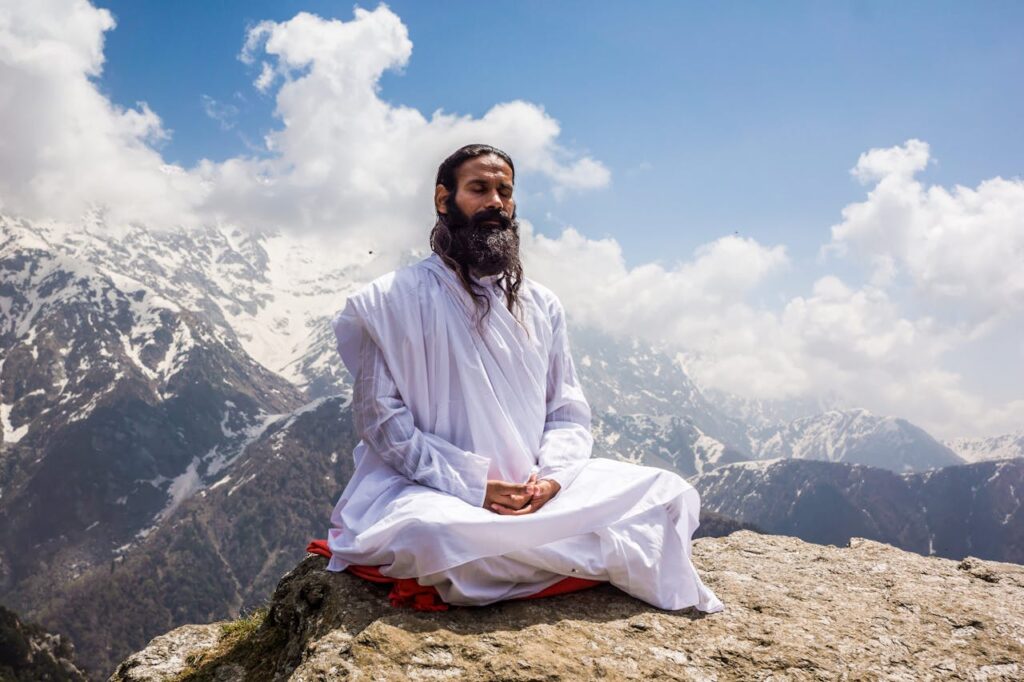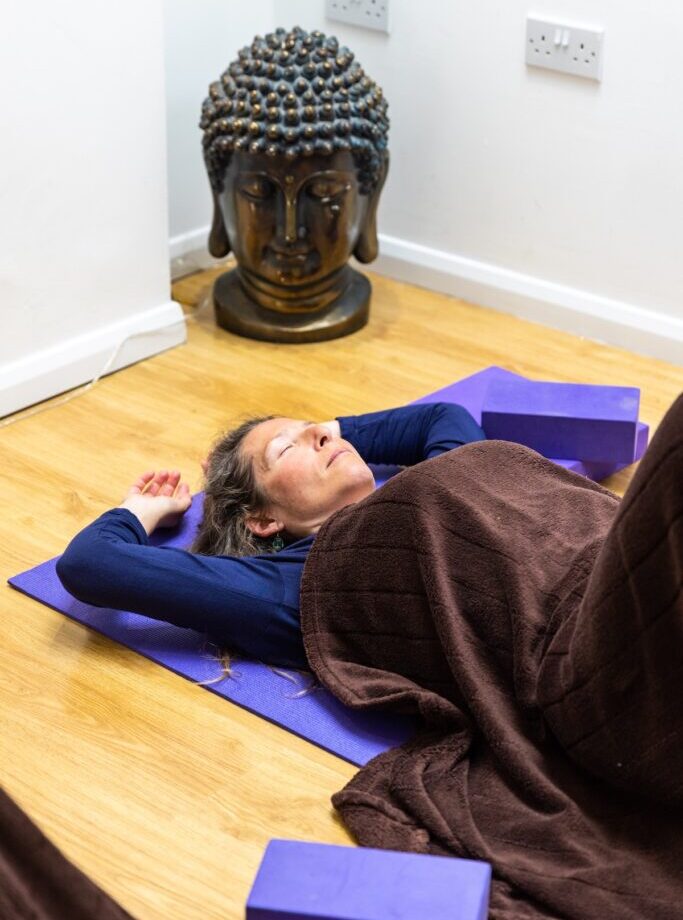What Is Yoga Nidra Really? Beyond Rest – Ancient Wisdom for Modern Life
Many people first encounter Yoga Nidra thinking it’s simply a long rest at the end of a yoga class, a chance to lie down, drift off and restore. And while Yoga Nidra can be deeply relaxing, to see it as just a tool for rest is to miss its true purpose entirely. Rooted in ancient yogic wisdom, Yoga Nidra is a profound practice of awareness and inner awakening. It invites us to explore states of consciousness beyond the thinking mind, gently guiding us towards our true nature, a place of peace, clarity and connection.
There is often confusion between Yoga Nidra, Savasana and meditation. Aren’t they basically the same? And how is ‘yogic sleep’ different from guided relaxation? To answer these questions, we need to travel back to the source, to the roots of Yoga Nidra and the traditions that first explored these states of consciousness. Let’s begin there.
What are the roots of Yoga Nidra?
The ancient yogis were on a quest to find the true nature of reality, our true selves and our connection with Spirit. They believed that we are not separate beings, but part of the Whole, the Divine, the same universal Source. In their search, they explored methods to help attain this state of consciounsess, where we can be free from all conditioning of the past, the senses and the mind.
They identified four primary states. Three of which we experience daily: waking, dreaming and deep sleep. But they also described a fourth state which they called Turiya. This fourth state was similar to deep sleep (stage 3 non REM sleep), but with awareness. A state of pure presence; of awakening to the reality of the infinite, beyond thought, beyond the senses and beyond identity. It is here, in this state where we can experience connection to the infinite, the essence of who we really are.
In the very early yogic texts, this state was referred to as Yoga Nidra, awakened yogic sleep. However, it was mentioned only as a state of consciousness, with no clear steps or instructions on how to achieve it. It is thought that maybe this was passed down through the oral tradition which is why there is no written record.
Most of the Yoga Nidra teachers of the past century gained wisdom directly from gurus, learning from their experiences, and through long periods of practise. They would then further develop and refine these learned techniques for their own students to reach this state. Others, such as Swami Veda Bharati of the Himalayan tradition, experienced this “Yoga Nidra state” through spiritual awakening, and then went on to develop their own systems to access it again.
Historical research shows that the Yoga Nidra we know today blends elements of traditional yoga practices, with 19th- and 20th-century Western relaxation techniques. Over the years, teachers have adapted the practices, and there are now many different styles of Yoga Nidra out there, each used for different intentions and purposes.
What is the difference between Yoga Nidra and Savasana?
Savasana is the final relaxation at the end of a Yoga class, where you rest fully. It’s purpose is to allow the body to integrate the effects of the practice you have just done. It’s a balance of doing and being.
Sometimes the teacher may guide you into physical relaxation by guiding you to systematically take your awareness around the body and invite release. This is similar to the body rotation stage in Yoga Nidra and the body scan used in some meditation practices, but Savasana is not Yoga Nidra.
Yoga Nidra is a structured practice with different stages, for example: gentle breath practices, visualiation of images and exploration of opposites. Not all Nidras include every stage, and different schools teach different approaches. Yoga Nidra can also have different intentions, for example: to inspire creativity, tune into the chakras, or help you get to sleep. While every Yoga Nidra is different, the practise is designed to guide awareness through different layers of being, allowing you to achieve deeper states of consciousness.
A Yoga Nidra works beautifully at the end of a longer yoga session, but it is not simply the systematic guidance around the body you may have experienced in Savasana. There is much more to it. Savasana is, essentially, a posture; Yoga Nidra is a systematic method for accessing deeper states of consciousness.
What is the difference between Yoga Nidra and Meditation?
Yoga Nidra is actually a form of meditation, although it is often mistaken for a relaxation practice. And yes, a Sleep Nidra can be very good for that, but the practice goes far beyond that. Yoga Nidra is a spiritual practice that helps you connect to “the Seer”, the part of you that is always aware of the comings and goings of the mind and emotions, observing from a place of neutrality.
The aim of Yoga Nidra is to remain aware while the body moves into a state similar to sleep, a space between wakefulness and dreaming known as the hypnagogic state. Unlike meditation which is traditionally practised in a seated posture, Yoga Nidra is usually practised lying down. However, the intention is the same: to cultivate awareness and access deeper states of consciousness.
We live in a world of duality: likes and dislikes, pleasure and pain, me and them, and so on. Much of our suffering arises from this perspective, which encourages us to judge and divide our experience. The Buddhist meditation practice of Vipassana instead teaches us to cultivate equanimity: reducing our habit of labelling, easing our craving for what we feel we lack, and softening our resistance to what is.
In one of the stages of Yoga Nidra, we are invited to explore opposite sensations – for example, heavy and light, hot and cold, asleep and awake. We are then guided to see if it is possible to experience both at the same time. In the same way that Vipassana cultivates equanimity, this exploration of opposites in Yoga Nidra reflects what is possible in daily life. It invites us to explore how two states can coexist – for example, we might feel unwell but still be ok, or feel hurt yet also peaceful.
This is a very sensitive stage to a Nidra and it’s important to be very careful how you use it which is why proper training is highly recommended.
Why take a Yoga Nidra course?
Yoga Nidra is a wonderful practice to help relax the nervous system, find rest and experience a taste of your true nature. When practiced regularly it can help sleep, encourage insights and creativity and support your well being. Learning how to teach it is a beautiful gift to yourself and to others.
Teaching Yoga Nidra requires more than reading from a script. Because the practice can guide someone into a very deep state of relaxation, it is important that they feel safe in the practice. This begins from the moment a person enters the space, in how you as the teacher, guide the experience – from creating the right environment, describing the practice and how and what you share. With trauma awareness Yoga Nidra has evolved over the years to help us as teacher share it as sensitively as possible.
On my Yoga Nidra Teacher Training (CPD) Course, you will learn what is happening in each stage and how to be mindful of what to teach. Once you have a deep understand of each stage you will be able to create your own Nidras based on your theme and students. A Nidra that flows from the heart rather than being read from a script in a book often has a different tone and quality to it.
If you feel called to explore this practice more deeply, whether for your own growth or to share with your students, I would love to welcome you onto Yoga Nidra Teacher Training (CPD) this January 23rd – 25th. The Early Bird price is only £425 (until 23rd November).
Article by: Louise Windsor






